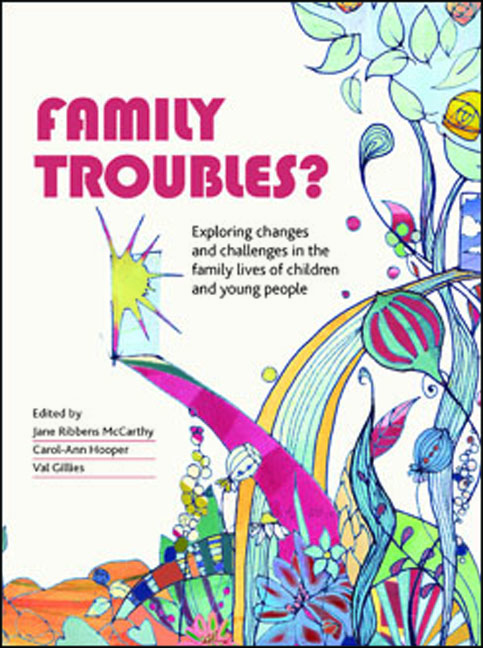Book contents
- Frontmatter
- Contents
- Notes on contributors
- Foreword
- Preface
- 1 Troubling normalities and normal family troubles: diversities, experiences and tensions
- Part One Approaching family troubles ? Contexts and methodologies :Introduction to Part One
- Part Two Whose trouble ? Conteste d definitions and practice: Introduction to Part Two
- Part Three The Normal, The Troubling And The Harmful?: Introduction to Part Three
- Part Four Troubles and transitions across space and culture: Introduction to Part Four
- Part Five Working With Families: Introduction to Part Five
- Index
7 - Normal problems or problem children? Parents and the micro-politics of deviance and disability
Published online by Cambridge University Press: 07 September 2022
- Frontmatter
- Contents
- Notes on contributors
- Foreword
- Preface
- 1 Troubling normalities and normal family troubles: diversities, experiences and tensions
- Part One Approaching family troubles ? Contexts and methodologies :Introduction to Part One
- Part Two Whose trouble ? Conteste d definitions and practice: Introduction to Part Two
- Part Three The Normal, The Troubling And The Harmful?: Introduction to Part Three
- Part Four Troubles and transitions across space and culture: Introduction to Part Four
- Part Five Working With Families: Introduction to Part Five
- Index
Summary
Introduction
The research presented here is part of a more comprehensive study of middleclass parents who identify their children as having significant problems, such as learning and developmental disabilities, mental illnesses, and substance addictions. The data are drawn from in-depth interviews with 34 mothers and 21 fathers who are predominantly white and middle-class. Focusing on the processes of problem construction, this chapter examines how parents came to view their children as having significant problems of a particular kind.
The author's analysis is informed by a social constructionist perspective that views all problems as emerging in social interaction. This does not imply that problems are ‘mere’ social inventions. On the contrary, the constructionist perspective holds that problems are real precisely because people identify and respond to them as such. All maladies, regardless of aetiology, require social acknowledgement in order to have meaningful consequences. In the words of Charles Rosenberg and Janet Golden (1992, p xxiv), an unknown disease is like a ‘tree falling in the forest with no ear to hear’.
As Robert Emerson and Sheldon Messinger (1977) argue in their seminal work on trouble, problems also are the outcomes of micro-political processes. Since every condition or behaviour contains multiple interpretive possibilities, the construction process can be fraught with uncertainty and conflict. Given the indeterminate nature of trouble, the micro-politics framework asks: who are the relevant social actors? What are their sources of power? What are their vested interests? Whose definitions of trouble prevail, in which contexts and why? This chapter draws from parents’ accounts to address these questions as they relate to the construction of children's problems.
There are a number of factors important to the construction process that are not fully addressed in this discussion. Central among these is what parents perceived to be the signs and symptoms of children's troubles. Children's conditions and behaviours provided a baseline for what interpretive trajectories were possible. In the contemporary West, for example, people view frequent seizures as medical problems, not products of wilful deviance. Although the meanings of children's problems were not inherent in their conditions and behaviours, dominant cultural understandings of those conditions and behaviours set the parameters for parents’ interpretations. Children's ages, the proliferation of information about particular problems (such as autism), and parents’ personal biographies also shaped definitions of the situation.
- Type
- Chapter
- Information
- Family Troubles?Exploring Changes and Challenges in the Family Lives of Children and Young People, pp. 85 - 96Publisher: Bristol University PressPrint publication year: 2013

